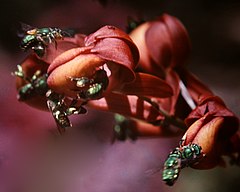Orchid bee
| Euglossini | |
|---|---|
 |
|
| male Euglossa at orchid Mormodes buccinator (Suriname) | |
| Scientific classification | |
| Kingdom: | Animalia |
| Phylum: | Arthropoda |
| Class: | Insecta |
| Order: | Hymenoptera |
| Family: | Apidae |
| Subfamily: | Apinae |
| Tribe: |
Euglossini Latreille, 1802 |
| Genera | |
| Diversity | |
| c. 200 species | |
Aglae
Euglossa
Eulaema
Eufriesea
Exaerete
The tribe Euglossini, in the subfamily Apinae, commonly known as orchid bees or Euglossine bees, are the only group of corbiculate bees whose non-parasitic members do not all possess eusocial behavior.
Most of the tribe's species are solitary, though a few are communal, or exhibit simple forms of eusociality. There are about 200 described species, distributed in five genera: Euglossa, Eulaema, Eufriesea, Exaerete and the monotypic Aglae. All exclusively occur in South or Central America (though one species, Euglossa dilemma, has become established in the United States). The genera Exaerete and Aglae are cleptoparasites in the nests of other orchid bees. All except Eulaema are characterized by brilliant metallic coloration, primarily green, gold, and blue.
Females gather pollen and nectar as food from a variety of plants, and resins, mud and other materials for nest building. Some of the same food plants are also used by the males, which leave the nest upon hatching and do not return.
Male orchid bees have uniquely modified legs which are used to collect and store different volatile compounds (often esters) throughout their lives, primarily from orchids in the subtribes Stanhopeinae and Catasetinae, where all species are exclusively pollinated by euglossine males. These orchids do not produce nectar, and hide the pollen on a single anther under an anther cap; they are not visited by females. The whole pollinarium becomes attached to the male as it leaves the flower. Several flowers from other plant families are also visited by the bees: Spathiphyllum and Anthurium (Araceae), Drymonia and Gloxinia (Gesneriaceae), Cyphomandra (Solanaceae), and Dalechampia (Euphorbiaceae) contain one or more species that attract male euglossines.
...
Wikipedia
